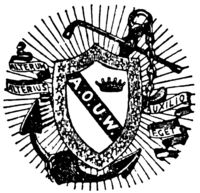Encyclopedia Dubuque
"Encyclopedia Dubuque is the online authority for all things Dubuque, written by the people who know the city best.”
Marshall Cohen—researcher and producer, CNN
Affiliated with the Local History Network of the State Historical Society of Iowa, and the Iowa Museum Association.
ANCIENT ORDER OF UNITED WORKMEN (A.O.U.W.)
ANCIENT ORDER OF UNITED WORKMEN (A.O.U. W.). John Jordan Upchurch formed this organization in 1868 in Meadsville, Pennsylvania. He wanted an organization that would be more responsive to the needs of its members and unite the conflicting interests of labor and management. This goal, however, soon (in 1869) gave way to providing benevolent insurance protection for its members’ widows and orphans.
The Iowa Lodge No. 11 of the AOUW was organized on July 13, 1888 in Dubuque. (1) Meetings were held every Friday evening in the hall on the corner of Main and Fourth STREETS. By 1887, the AOUW had more than 176,000 members in 3,200 member groups (called lodges) across the country.
The word “Workmen” was chosen as part of the new order’s name because its purpose was to serve and attract men in the mechanical trades. Only two years after the AOUW was formed, however, the order broadened its membership requirements to permit other occupations.
Through Upchurch, a Freemason, the AOUW took on a number of Masonic features. Its ritual was secret; the square and compass and the all-seeing eye were organizational symbols. At first there were four degrees, but in 1871 the ritual was revised to work only three degrees. The Bible, as in Masonry, also was an important symbol.
Most historians of fraternal insurance credit the AOUW as being the first fraternal group that introduced fraternal insurance. During the society’s first year of existence there was as much emphasis on improving unfavorable conditions for workingmen as there was on its insurance fund, which allowed no more than $500 to be paid to the “legal heirs of a deceased member.”
The real emphasis on fraternal insurance began on October 6, 1869. The amended article stated that each initiated new member paid $1.00 to the insurance fund. After a member died, his beneficiaries received $2,000. Depleted funds were to be restored by each member contributing another $1.00. This procedure was to be repeated each time the fund required restoration. This method was known as the post-mortem plan or the assessment-as-needed plan. If any member failed to pay his $1.00 fee in thirty days, he forfeited his membership in the order. If a subordinate lodge failed to forward the amount of the insurance fund in twenty days, it lost its charter.
To offer workingmen life insurance was a new idea in the late 1860s, especially when the idea of American insurance was less than twenty years old at that time. Before this life insurance had been available only to businessmen and manufacturers. Because there were many bankruptcies of commercial life insurance firms, AOUW leaders were convinced that life insurance would succeed only in fraternal societies where overhead expenses would be small.
The AOUW, compared to numerous other fraternal benefit societies, was quite progressive. It took the initiative of calling together a number of fraternal benefit societies in 1886. This action caused sixteen fraternal benefit groups to form the National Fraternal Congress in that same year. This cooperative association worked to establish uniform and sound insurance practices among all fraternal benefit societies. The National Fraternal Congress is still in existence today with 121 member societies.
The society revised its ritual a number of times. Every revision attempted to match the ritual and the order’s objectives. The religious qualities of the ritual were deleted from the revision of 1932.
The watchwords of the AOUW were “Charity, Hope, and Protection.”
The AOUW, which by 1885 was the largest fraternal benefit society in America, discontinued its supreme lodge structure in 1929. A congress was established in place of the supreme authority. In 1952 the AOUW dissolved or merged with various state societies. Washington was the only state where the society continued to exist. In other states the order frequently merged or converted to mutual insurance companies.
---
Source:
Ancient Order of United Workmen (A.O.U.W.) http://www.phoenixmasonry.org/masonicmuseum/fraternalism/aouw.htm
Ancient Order of United Workmen (A.O.U.W.) http://www.stichtingargus.nl/vrijmetselarij/aouw_en.html


